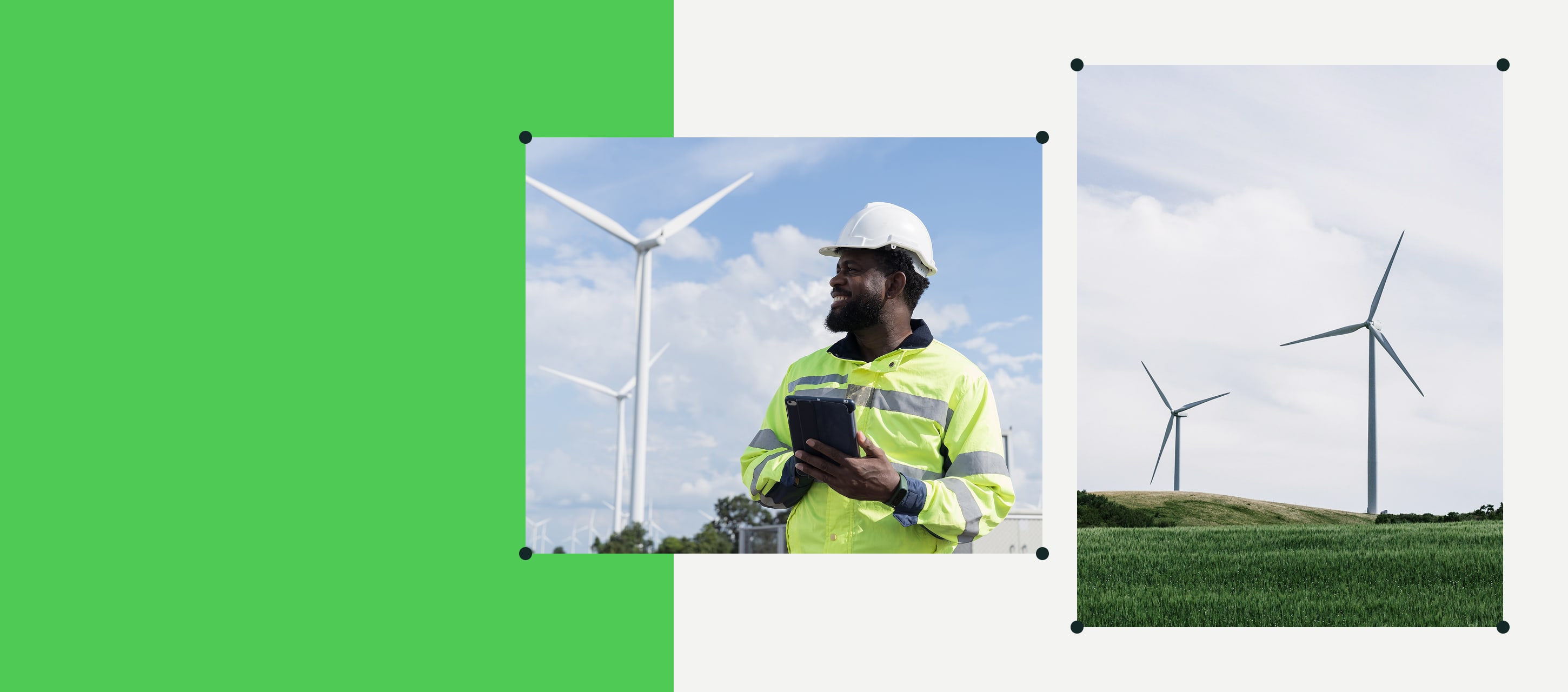A solar farm is more than panels and sunlight. It takes routine inspections, maintenance, and timely repairs to consistently deliver clean energy for a greener world.
This guide outlines the essential practices that help solar farms operate smoothly and reliably.This guide outlines the essential practices that help solar farms operate smoothly and reliably.
Contents:
What Is Solar Operations and Maintenance?
Solar operations and maintenance (O&M) is the structured care and oversight of solar PV systems to ensure they produce energy efficiently, safely, and reliably throughout their lifespan.
This includes scheduled tasks like preventive maintenance, unexpected repairs through corrective maintenance, and advanced techniques like predictive maintenance. Together, these actions reduce downtime, minimize soiling losses, and improve inverter efficiency.
At its core, solar O&M helps companies achieve 6 key goals:
- Maximize energy yield (kWh/kWp)
- Maintain performance ratio (PR)
- Extend solar farm lifespan and reduce degradation rate
- Keep systems compliant with safety protocols and environmental regulations
- Manage warranties, spare parts, and O&M contracts effectively
- Prevent faults and respond to them quickly using remote monitoring and diagnostics
Why Is O&M Important in the Solar Industry?
A well-maintained solar farm pays off in real savings and reliability. Here’s why it matters:
- Maximizing Energy Efficiency. Even a light layer of dust, as little as 4.5 grams per square meter, can drop panel efficiency by 12%. Routine cleaning and inspections prevent this, ensuring you’re getting the most energy from your system.
- Cutting Costs. With regular maintenance, you catch small issues before they turn into big, expensive problems. This means fewer repair bills, steadier energy production, and higher returns.
- Extending the Life of Solar Components. Routine O&M helps your equipment last longer, saving you from early replacements.
- Ensuring Safety and Preventing Hazards. By catching risks early, you keep team members safe and prevent accidents.
- Staying Compliant with Industry Standards. Maintenance keeps your farm up-to-date with safety and environmental standards, avoiding fines, legal troubles, and shutdowns.
Ultimately, solid solar site operations, guided by experienced O&M providers and supported by the right software, ensures every component delivers as promised.
Read More: 10 best Fieldwire alternatives for maintenance management in 2025
Which Components of the Solar Farm Should Be Maintained?
Just like every engine needs its oil, each part of your solar farm needs the right care. Here’s a look at what that means across your system:
- PV Modules: These need regular module cleaning to prevent soiling losses and visual inspections for cracks, discoloration, or hotspots.
- Inverters: As the power converters, inverters require firmware updates, inverter monitoring, cooling checks, and log reviews to ensure optimal inverter efficiency.
- Mounting Structures: Corrosion checks and bolt tightening help maintain structural integrity – critical during extreme weather.
- Cabling & Connectors: Insulation testing and infrared thermography detect fraying or overheating wires before they become a danger.
- Combiner Boxes: These junction points need regular fuse and breaker checks, plus thermal imaging inspection to catch early signs of failure.
- Monitoring Systems: From SCADA system monitoring to sensor calibration and software updates, these systems drive fault detection and diagnostics.
- Batteries (in hybrid systems): Performance hinges on capacity checks, charge cycles, and temperature monitoring.
- Transformers: If used, they require oil sampling (for oil-filled types) and thermal scanning to ensure safe voltage conversion.
It’s worth noting that this list covers the essential needs of most grid-tied and utility-scale solar farms. However, the exact components can vary depending on the type and design of the farm.
For example, hybrid systems may include batteries, generators, or advanced controllers, requiring additional checks. And farms with tracking systems need maintenance on motors and alignment sensors.
What Are the Types of Solar Farm Maintenance?
Although maintenance varies based on your strategy, most farms use a blend of these 3:
1. Preventive Maintenance (Scheduled Maintenance)
This is your regular check-up: routine task scheduling like vegetation management, module cleaning, and system testing. It’s central to every effective solar farm maintenance plan.
2. Corrective Maintenance (Unscheduled Maintenance)
This one steps in when unexpected issues (like panel damage or inverter faults) need immediate attention. Its goal is rapid recovery to minimize energy losses.
3. Predictive Maintenance
Using data analytics, SCADA system monitoring, and IV curve testing, predictive maintenance spots trends and flags potential issues before they interrupt production.
Read More: How CPP slashed wind farm inspection time by 43% using automation
How Often Should Solar Farms Be Maintained?
For most homeowners and smaller solar farms, a quarterly or even yearly inspection and cleaning is usually all that’s needed. Large solar farms often set up daily or weekly check-ins to catch small issues early, before they turn into bigger, more expensive problems.
Although solar plant maintenance timing depends on system size, environment, and components, most O&M providers follow a reliable cycle:
| Task | Frequency |
|---|---|
| Remote monitoring | Daily |
| Visual inspection | Monthly |
| Module cleaning | Quarterly |
| Inverter maintenance | Semi-annually |
| Grounding system inspection | Annually |
| IV curve testing | Annually |
| Thermography inspection | Annually |
| Vegetation management | Quarterly |
| Safety drills | Annually |
While this schedule is a reliable starting point, it may fall short in challenging environments where dirt, weather, or vegetation accumulate faster. Fixed schedules also don’t account for real-time data, which can lead to unnoticed faults between inspections.
To address these (and some other) issues, schedules should be dynamic and adjusted based on site conditions, remote monitoring insights, and manufacturer guidelines. This way, high-risk components get more attention and warranty terms are met.
Solar O&M Standards
To stay compliant and efficient, solar farms need to follow key global and local standards. Here are the main ones:
- IEC 62446: Covers documentation, commissioning, and maintenance best practices
- IEC 61724: Focuses on PV system performance monitoring
- IEEE 1547: Regulates interconnection between solar farms and the grid
- NFPA 70 (NEC): Electrical safety and fire protection standards
- Local fire and environmental codes: Mandates for vegetation management, spill response, and structural fire safety
Core standards (like IEC and IEEE) provide a universal foundation but geographic location heavily influences how those standards are applied and what additional rules you must follow. It’s always a good idea to consult local authorities and follow solar O&M best practices for full regional compliance.
Metrics of Solar O&M Success
How do you know your O&M strategy is working? By looking at these 6 metrics:
1. Performance Ratio (PR)
Measures how well your system performs against ideal conditions.
How to Track: Use SCADA system monitoring or Remote Monitoring platforms to compare real-time output with expected output based on irradiance and temperature data.
Pro Tip: Set thresholds and alerts when PR drops below a defined baseline. This flags inefficiencies early.
2. Energy Yield (kWh/kWp)
Total kilowatt-hours produced per kilowatt of installed capacity over a specific time period.
How to Track: Automatically calculated in most inverter monitoring software and performance dashboards.
Pro Tip: Track this monthly and seasonally to detect trends and plan for seasonal performance tuning.
3. Uptime vs. Downtime
Percentage of time the system is operational versus offline due to faults or maintenance.
How to Track: Use your O&M software or digital maintenance logs to timestamp fault events, resolution times, and scheduled outages.
Pro Tip: Prioritize assets with high downtime for predictive diagnostics or schedule Preventive Maintenance.
4. Inverter Efficiency
Ratio of AC output to DC input power.
How to Track: Access inverter monitoring dashboards and export data logs for periodic analysis.
Pro Tip: Watch for declining trends that may indicate cooling issues, firmware faults, or wiring inefficiencies.
5. Soiling Losses
Energy output loss due to dirt, dust, or bird droppings on PV modules.
How to Track: Use baseline-cleaned module testing vs. current production, or install reference modules with automated cleaning.
Pro Tip: Combine visual inspection logs and periodic IV Curve Testing to correlate drops with soiling impact.
6. Degradation Rate
Year-over-year decline in panel efficiency.
How to Track: Compare current energy yield with initial system performance under similar irradiance conditions using long-term data trends.
Pro Tip: Flag panels that degrade faster than the warranty allowance for proactive Warranty Claim Management.
To ensure you have accurate tracking across all metrics, keep your monitoring systems properly calibrated, maintain clean and complete maintenance logs, and align your data points with a centralized O&M platform. Regular audits and quality checks further strengthen data reliability.
How Fluix Improves Solar Farm O&M
Operation and maintenance of a solar power plant is complex. But they don’t have to be overcomplicated.
Fluix is a mobile-first platform that helps you simplify solar O&M with mobile inspection software and intelligent workflows.
- Streamlined Inspections: Use digital forms to cut down inspection time and log every check with accuracy.
- Mobile & Offline Functionality: Field techs can complete inspections offline, with instant sync once reconnected.
- Centralized Maintenance Logs: All records in one place, from inverter monitoring to vegetation management, help meet compliance and warranty terms.
- Automated Alerts: Real-time fault detection and diagnostics help flag issues early.
- Standardized Protocols: Ensure every site follows the same fire drills, spill response actions, and seasonal performance tuning schedules.
Fluix turns your solar O&M program into a well-oiled machine. And we’re not new to this. We’ve been helping renewable energy operators like Siemens Gamesa, RWE and Vattenfall improve field maintenance for over a decade. Want to see how?






